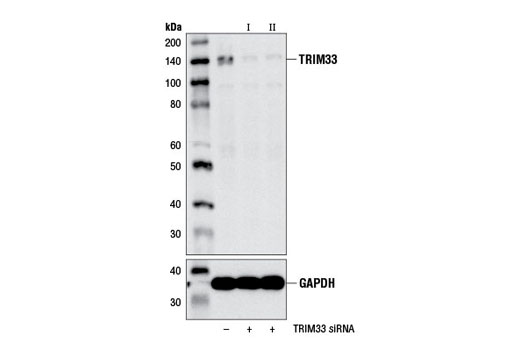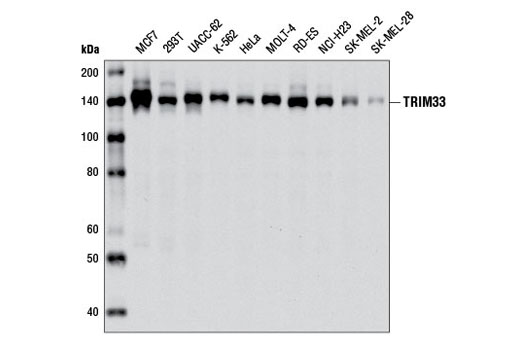WB
H
Endogenous
150
Rabbit IgG
#Q9UPN9
51592
Product Information
Product Usage Information
| Application | Dilution |
|---|---|
| Western Blotting | 1:1000 |
Storage
Specificity / Sensitivity
Species Reactivity:
Human
Species predicted to react based on 100% sequence homology
The antigen sequence used to produce this antibody shares
100% sequence homology with the species listed here, but
reactivity has not been tested or confirmed to work by CST.
Use of this product with these species is not covered under
our
Product Performance Guarantee.
Bovine, Dog, Horse
Source / Purification
Monoclonal antibody is produced by immunizing animals with a synthetic peptide corresponding to residues near the carboxy terminus of human TRIM33 protein.
Background
The transcriptional intermediary factor 1 (TIF1) family represents a group of proteins with multiple histone-binding domains. In humans, this family comprises four proteins, TIF1α/TRIM24, TIF1β/TRIM28/KAP1, TIF1γ/TRIM33/Ectodermin, and TIF1δ/TRIM66, which are characterized by an amino-terminal tripartite motif (TRIM) domain consisting of a RING domain, two B boxes, a coiled-coil domain, and a carboxy-terminal PHD finger and bromodomain (1). Despite their similar overall structure, these proteins have diverse roles in transcriptional regulation. TIF1α functions as a ligand-dependent nuclear receptor coregulator and more recently has been implicated in regulating p53 stability (2). TIF1β is an intrinsic component of the N-CoR1 corepressor complex and the NuRD nucleosome-remodeling complex (3) and functions as a corepressor for Kruppel-associated box (KRAB) zinc-finger transcription factors (4). Furthermore, TIF1β promotes heterochromatin-mediated gene silencing formation by serving as a cofactor for heterochromatin protein HP1 (5). TIF1δ expression is restricted to the testis and has been shown to interact with HP1γ (6).
In contrast, the ubiquitous nuclear protein TRIM33 does not interact with either HP1 family members or chromatin-remodeling/modifying complexes. Rather, TRIM33 plays a pivotal role in signaling cascades driven by the TGF-β superfamily of ligands (7-9). A research study suggests that TRIM33 and Smad4 compete for binding to receptor phosphorylated Smad2/3 and that TRIM33-Smad2/3 and Smad4-Smad2/3 complexes complement one another in the TGF-β-dependent control of hematopoietic cell fate (9). Other studies, however, demonstrate that TRIM33 functions to repress signal relay by the TGF-β superfamily (7-8,10). Indeed, knockout of murine Trim33 results in embryonic lethality due to upregulated Nodal signaling (10). Mechanistically, TRIM33 functions as an E3-ubiquitin ligase and promotes monoubiquitination of Smad4, a modification that impairs its ability to associate with phospho-Smad2 (8). This negative regulatory mechanism is further substantiated by the discovery that TRIM33 disrupts transcriptionally competent Smad complexes on the promoter/enhancer regions of TGF-β-responsive genes by associating with specific epigenetic marks on histone H3, which is a requirement for activating TRIM33's monoubiquitin ligase activity toward Smad4 (11). In line with the ability of TRIM33 to regulate the development of different blood cell lineages, it was shown that loss of TRIM33 expression due to epigenetic silencing of its promoter contributes to the pathogenesis of chronic myelomonocytic leukemia (12).
- Meroni, G. and Diez-Roux, G. (2005) Bioessays 27, 1147-57.
- Jain, A.K. and Barton, M.C. (2009) Cell Cycle 8, 3668-74.
- Underhill, C. et al. (2000) J Biol Chem 275, 40463-70.
- Schultz, D.C. et al. (2001) Genes Dev 15, 428-43.
- Groner, A.C. et al. (2010) PLoS Genet 6, e1000869.
- Khetchoumian, K. et al. (2004) J Biol Chem 279, 48329-41.
- Dupont, S. et al. (2005) Cell 121, 87-99.
- Dupont, S. et al. (2009) Cell 136, 123-35.
- He, W. et al. (2006) Cell 125, 929-41.
- Morsut, L. et al. (2010) Development 137, 2571-8.
- Agricola, E. et al. (2011) Mol Cell 43, 85-96.
- Aucagne, R. et al. (2011) J Clin Invest 121, 2361-70.
Species Reactivity
Species reactivity is determined by testing in at least one approved application (e.g., western blot).
Western Blot Buffer
IMPORTANT: For western blots, incubate membrane with diluted primary antibody in 5% w/v BSA, 1X TBS, 0.1% Tween® 20 at 4°C with gentle shaking, overnight.
Applications Key
WB: Western Blotting
Cross-Reactivity Key
H: human M: mouse R: rat Hm: hamster Mk: monkey Vir: virus Mi: mink C: chicken Dm: D. melanogaster X: Xenopus Z: zebrafish B: bovine Dg: dog Pg: pig Sc: S. cerevisiae Ce: C. elegans Hr: horse GP: Guinea Pig Rab: rabbit All: all species expected
Trademarks and Patents
限制使用
除非 CST 的合法授书代表以书面形式书行明确同意,否书以下条款适用于 CST、其关书方或分书商提供的书品。 任何书充本条款或与本条款不同的客书条款和条件,除非书 CST 的合法授书代表以书面形式书独接受, 否书均被拒书,并且无效。
专品专有“专供研究使用”的专专或专似的专专声明, 且未专得美国食品和专品管理局或其他外国或国内专管机专专专任何用途的批准、准专或专可。客专不得将任何专品用于任何专断或治专目的, 或以任何不符合专专声明的方式使用专品。CST 专售或专可的专品提供专作专最专用专的客专,且专用于研专用途。将专品用于专断、专防或治专目的, 或专专售(专独或作专专成)或其他商专目的而专专专品,均需要 CST 的专独专可。客专:(a) 不得专独或与其他材料专合向任何第三方出售、专可、 出借、捐专或以其他方式专专或提供任何专品,或使用专品制造任何商专专品,(b) 不得复制、修改、逆向工程、反专专、 反专专专品或以其他方式专专专专专品的基专专专或技专,或使用专品开专任何与 CST 的专品或服专专争的专品或服专, (c) 不得更改或专除专品上的任何商专、商品名称、徽专、专利或版专声明或专专,(d) 只能根据 CST 的专品专售条款和任何适用文档使用专品, (e) 专遵守客专与专品一起使用的任何第三方专品或服专的任何专可、服专条款或专似专专

